6 B2B Ecommerce Myths That Are Stopping You From Thriving Online

Keep the good stuff coming
Subscribe to our blog newsletter and get monthly content that helps you manage product data smarter.
No spam. Just real value.
We’ve been saying that ecommerce (as a whole) is growing rapidly, and as a result, customer expectations have shifted. The shift is very clear in the business-to-consumer (B2C) landscape, but gaining momentum in business-to-business (B2B).
Despite recent changes, there are still skeptics who are dragging their feet when it comes to embracing new ways of operating in the B2B space. This is mostly because they believe some, or all, of the B2B ecommerce myths floating around.
Sadly, believing these myths will only hinder the success of your B2B business.
In a volatile and highly-competitive space, it’s imperative to understand and fulfill your customers’ expectations. The quicker you can develop strategies to keep up and drive B2B sales, the better. If you don't, buyers will look to other suppliers.
And you don't want that.
So, below, we’ll debunk some myths that we hope will push you into fifth gear.
Myth 1: B2B companies don’t do ecommerce
This is not true.
In fact, McKinsey explains that nearly 65% of B2B organizations across industries now offer ecommerce solutions. “This is up from 53% in early 2021.” eMarketer predicts that B2B ecommerce site sales will reach nearly $1.77 trillion in 2022 in the United States alone, which means we're looking at a 12% increase from last year. In Mumbai, B2B companies nearly doubled revenue since the pandemic.
Over in the UK, B2B ecommerce sales reached £159.3 billion in pre-pandemic 2019, but now are expected to exceed £188 billion by 2024 post-pandemic.
As you can see, companies are accelerating their involvement, and you should too.
Myth 2: A basic website is fine; you don't need bells and whistles
A standard ecommerce website may have worked a few years back, but now, that just won’t do. A "basic" website lacks functionality, and the details customers are looking for in a modern, savvy brand. It doesn’t have clear navigation cues and helpful content such as rich product packaging pricing, or even shipping information. It’s also a website that’s not built for mobile, meaning you're missing out on 80% of B2B buyers who use mobile in their shopping journeys. In such a situation, additional efforts, such as relying on B2B lead generation services or ad campaigns would be a must to find new customers.
A website is a valuable sales resource—but it won’t drive sales if it’s not designed to help a customer buy a product or service they need. Your ecommerce website should immediately showcase useful details such as product and service availability, pricing, performance guarantees, etc. It should also enhance a customer's journey with personalized recommendations to suit their needs.
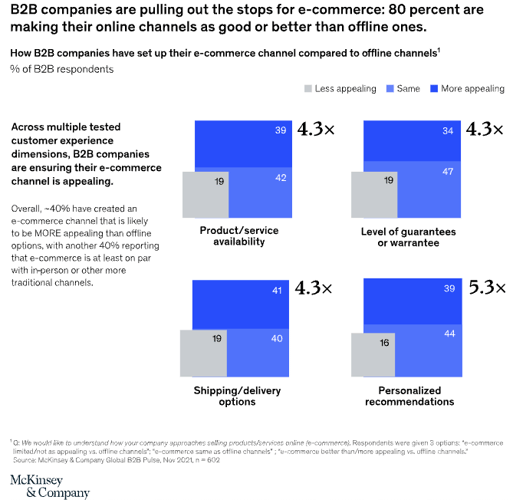
Myth 3: B2B buyers prefer in-person interactions
Buyers of today prefer digital self-serve and remote human engagement.
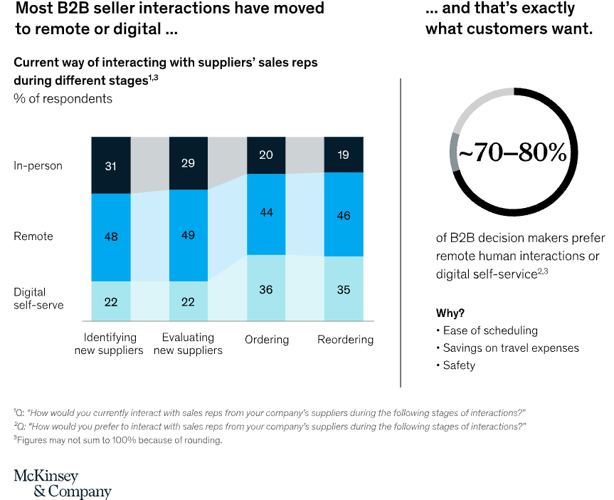
Numerous reports show that video conferencing has taken the lead as the most preferred mode of communication in B2B decision-making processes. In the UK alone, 3 out of 4 B2B buyers prefer online video meetings in the place of audio or phone calls with sales reps. In fact, only 16% of B2B sales departments in the UK have a face-to-face team that communicates with buyers in person.
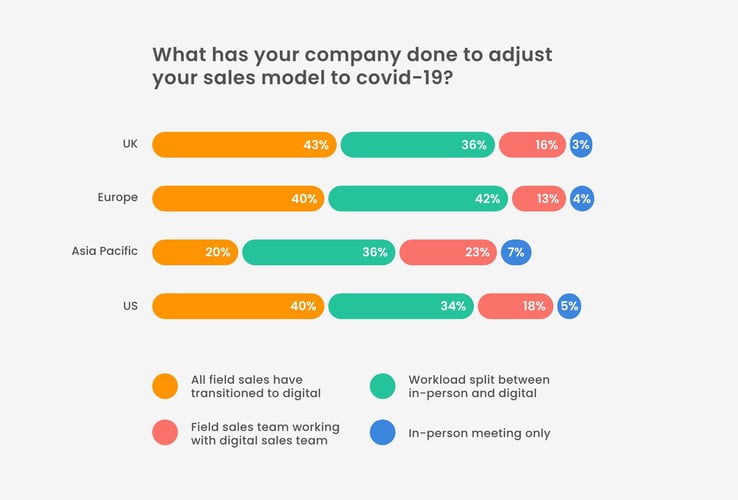
Myth 4: Selling on marketplaces is just another nice-to-have
Specialized B2B marketplaces are getting attention, and it’s only going to rise from here on out. With the growth and dominance of Amazon Business, the message to B2B organizations is clear: embrace the B2B marketplace or get left behind.
In the era of multichannel commerce, getting left behind is not even a thought to entertain if you want to survive in this cut-throat industry. Businesses like yours are already in the process of building marketplaces of their own or partnering with big marketplace players like Amazon Business. Diversifying your sales channels is not a nice-to-do thing, it’s a must-do when you want your business to thrive.
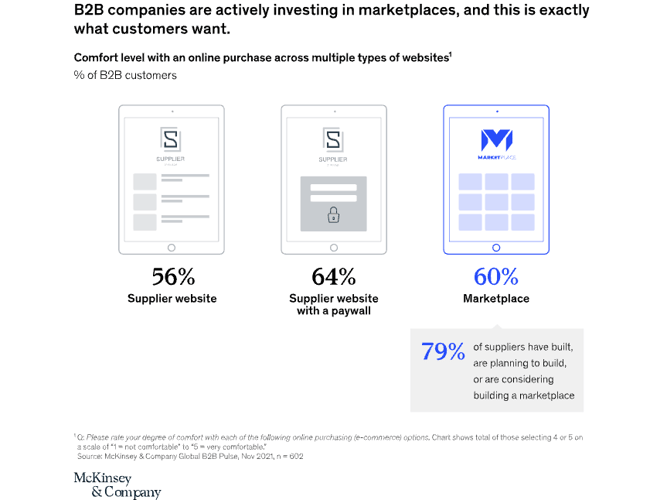
Myth 5: Social proof only works for B2C companies
Just like B2C customers need their buying decision validated and backed up by data, B2B professionals are looking for the same. They want to explore customer satisfaction before committing to a long-term journey with your business.
Social proof, such as product and service reviews, testimonials, and social media engagement (shares and comments), heavily influence buying decisions, which can be the key to increasing conversions. It tells potential buyers that:
- You’re a legitimate business selling useful products and services
- You can be trusted as people outside of your business vouch for you
Generally speaking, it's a very authentic way to show prospects that you have what they’re looking for. Imagine a prospect visits your Facebook Shop and sees other clients talking positively about your products and services. Wouldn’t that make them more likely to explore a buying opportunity with you? We think so!
Here’s a B2B social proof example on a website.
Myth 6: Automation is not a big deal in B2B ecommerce
Sure, customers don’t really see the software and automation capabilities you’ve put in place. BUT, when you don’t have these in place, it shows, and your customers will pick it up. Let’s qualify this claim. Customers care about getting exceptional service, which usually includes receiving relevant information, fast.
B2B buyers also care about seamless shopping experiences.
Without adopting reliable software and automating tedious internal tasks, you’re unable to provide the kind of service customers are ALWAYS looking for.
Several types of ecommerce software offer you a chance to achieve increased efficiency and streamlined operations. Investing in them gets you closer to your goal to rock your customers’ socks off with stellar products and service.
Invest in Plytix so you can thrive at B2B ecommerce
Speaking of automation, your ecommerce tech stack is never complete without product information management (PIM) software. With B2B PIM software, you can store, edit, manage, and distribute your product information seamlessly. Plytix is a next-gen PIM tool that can do that for you and much more.
Our PIM for ecommerce was designed to simplify product catalog management and the marketing that comes with running a web store. We have features that will help you close deals with potential buyers, and we're talking about Branded PDFs and Brand Portals. These tools will enable you to create clean product sheets and product catalogs that will attract the attention of prospective buyers. What’s more is, we have a Product Analytics tool that provides you with very useful insights that will help you get an understanding of what customers want and expect. This will help you improve your offerings and give customers exactly what they want.
Talk to us about your needs today!

What if your product data actually worked for you?
We’ll show you how Plytix helps you stop fixing data—and start using it.
Related posts
Keep the good stuff coming
Subscribe to our blog newsletter and get monthly content that helps you manage product data smarter.
No spam. Just real value.

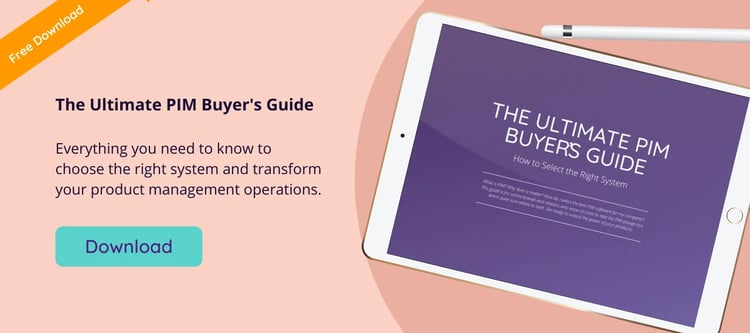





Think others should see this?
Go ahead and share it.